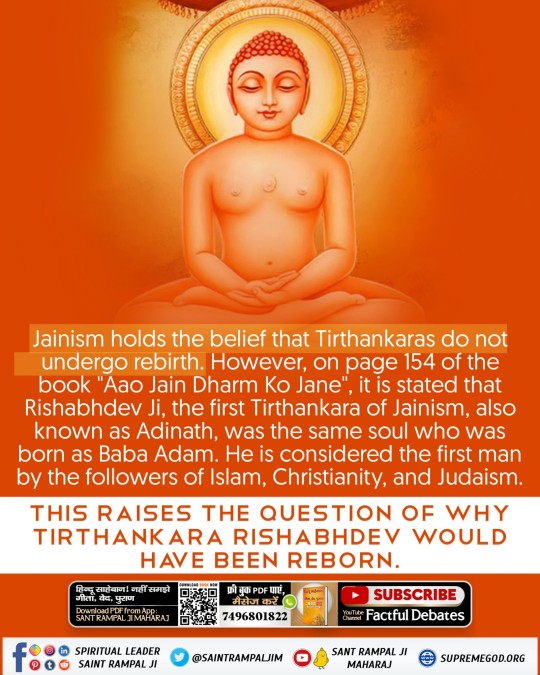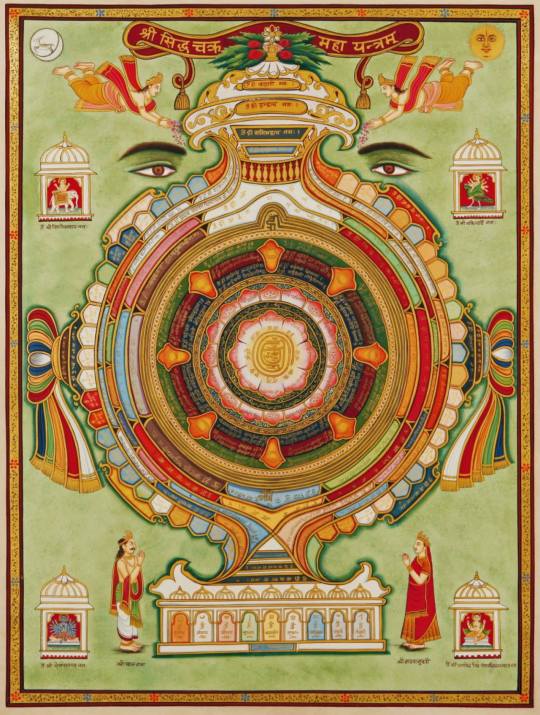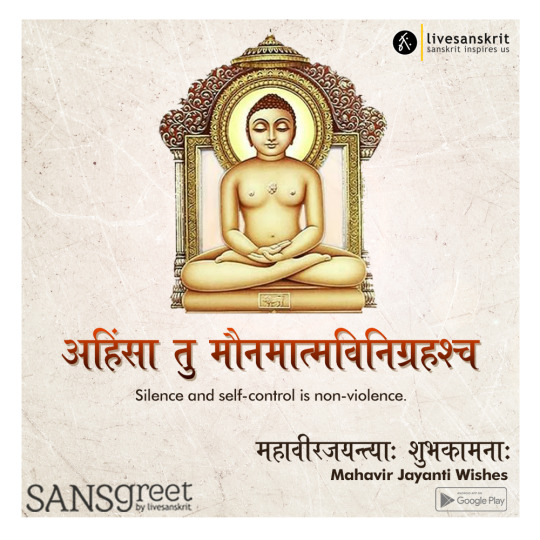#Jain Tirthankaras
Text
Why does Jain celebrate Diwali?
Why does Jain celebrate Diwali?
Diwali has a very special significance in Jainism. For the Jain community, the festival commemorates the enlightenment and liberation (moksha) or Nirvana (final release) of Mahavira, the most recent of the Jain Tirthankaras, from the cycle of life and death (samsara). The lighting of the lamps celebrates the light of Mahavira’s holy knowledge.
Nirvan Ladoo is…

View On WordPress
#austerity#calmness#celebrate#chant hymns#Charity#cycle of life and death#Diwali#diyas#enlightenment#environment-consciousness#equity#fasting#Festival#final release#firecrackers#homes#Jain#Jain community#Jain temples#Jain Tirthankaras#Jainism#Knowledge#liberation#lighting of the lamps#lights#Lord Mahavira#Mahavira#Mahavira’s holy knowledge#mantras#moksha
0 notes
Text

#FactsAndBeliefsOfJainismJainism holds the belief that Tirthankaras do not undergo rebirth. However#on page 154 of the book “Aao Jain Dhar
0 notes
Text
Discover the Tranquility of Shree Kangra Jain Shwetambar Tirth | Himachal Pradesh
Nestled amidst the breathtaking beauty of Kangra in Himachal Pradesh, Shree Kangra Jain Shwetambar Tirth is a haven of tranquillity and spirituality. This magnificent Jain temple holds within its sacred walls an extraordinary statue of Adinath, the first Tirthankara of Jainism, as well as a priceless stone sculpture that dates back more than three thousand years.
As you step into the premises of…

View On WordPress
0 notes
Text

Siddhachakra Mahayantra
The Siddhachakra Yantra is one of the most important and popular Jain yantras (mystical diagrams). The central lotus has symbolically encircled five supreme beings namely Arihant (Tirthankara) in the centre and Siddha (the liberated souls), Acharya (Mendicant leader), Upadhyaya (Mendicant preceptor) and Sadhu (Mendicant) as well as Samyak-jnana (right knowledge), Samyak-charitra (right conduct) Samyak-darshan (right belief) and Samyak-tapa (right asceticism) in eight petals. Alternate petals on outer circle have various mantras. At the bottom of the painting, Raja Shripala and his queen Mayanasundari are shown worshipping the yantra
58 notes
·
View notes
Text


22nd Jain Tirthankara Neminatha in Lotus Position [1151]
unknown artist
Horniman Museum and Gardens
37 notes
·
View notes
Text
TIRTHANKARAS’ (JAINS’ 24 GODS’) TIME-FRAME:
1. 6,30,000 BCE – Shiva/Adi nath
2. 4,50,000 BCE – Ajit nath
3. 3,00,000 BCE – Sambhav nath
4. 2,80,000 BCE – Abhinandan nath
5. 2,40,000 BCE – Sumati nath
6. 2,20,000 BCE – Padmaprabh
7. 1,90,000 BCE – Suparshva nath
8. 1,50,000 BCE - Chandraprabh
9. 1,30,000 BCE - Pushpadant
10. 1,10,000 BCE – Shital nath
11. 1,00,000 BCE – Shreyans nath
12. 98,000 BCE - Vasupujya (Ie. Half of Jain Tirthankars had already come & attained self-realization/liberation, till 1 L yrs back!)
13. 94,000 BCE – Vimal nath
14. 89,000 BCE – Anant nath
15. 74,000 BCE – Dharm nath
16. 70,000 BCE – Shanti nath
17. 67,000 BCE – Kunthu nath
18. 62,000 BCE – Ara nath
19. 58,000 BCE – Malli nath
20. 54,000 BCE - Munisuvrat
21. 10,000 BCE – Nami nath (Ie. Only 4 Tirthankaas have attained nirvana, in Vedic times)
22. 3,400 BCE – Nemi nath
23. 1,700 BCE – Parshva nath
24. 1,200 BCE – Mahavir
Did You Know-
20/24 Jain Tirthankars/Gods have attained nirvan (jivan-maran mukti or liberation from life-death cycle or Moksh) in Shikharji, Jharkhand (earstwhile Bihar).
The other 4 sites are Kailash, Tibet, obvi for Shiva/Adinath, & Pavapuri, Nalanda for Mahavir, Champapuri, Bhagalpur, Bihar for Vasupujya, & Girnar, Gujarat for Nemi nath (actual cousin of Krishna!)

2 notes
·
View notes
Text
The Mount Kailash
Huge mass of black rock
22,000 feet high
Most venerated holy place
Least visited though
Supremely sacred site of Four religions
Remote location in far western Tibet
The weather is always cold
Known as the Axis Mundi, the center and birthplace of the entire world
It was perhaps a sacred place of another era, another civilization, now long gone and forgotten.
The believers walk around the peak but it is never climbed
Trekking all the way up to the peak of Mount Kailash is held to be a forbidden act among Hindus for the fear of trespassing the sanctity of the mountain and disturbing the divine energies residing there.
The Religious Perspective:
Hindus believe Mt.Kailash to be the abode of Lord Shiva. Shiva is a character of apparent contradictions. He was the Lord of Yoga and the divine master of Tantra. According to legend, the immortal Shiva lives atop Kailash where he spends his time practicing yogic austerities, making joyous love with his divine consort, Parvati, and smoking ganja.
The Jains call the mountain Astapada and believe it to be the place where Rishaba, the first of the twenty-four Tirthankaras attained liberation.
Followers of Bon, shamanistic religion, call the mountain Tise and believe it to be the seat of the Sky Goddess Sipaimen. Additionally, Bon myths regard Tise as a legendary 12th century battle of sorcery between Buddhism and Bon because of Buddhist sage Milarepa and the Bon shaman Naro Bon-chung.
Milarepa's defeat of the shaman displaced Bon as the primary religion of Tibet, firmly establishing Buddhism in its place. The religion of Buddhism only entered Tibet, via Nepal and India, in the 7th century AD.
Pilgrims to Kailash are essentially walking around the mountain (clockwise for the Buddhists, counter-clockwise for Bon adherents) normally takes three days. A hardy few, practicing a secret breathing technique known as Lung-gom, will power themselves around the mountain in only one day.
14 notes
·
View notes
Text
GROWBILLIONTREES | Trees For Mahavir Jayanti

Mahavir Jayanti, a significant day for Jain communities worldwide, commemorates the birth of Lord Mahavir, the twenty-fourth Tirthankara of Jainism.
On this auspicious occasion, as we reflect on the teachings of compassion, non-violence, and environmental stewardship imparted by Lord Mahavir, it's opportune to embrace initiatives that align with these principles. One such noble endeavor is the planting of trees, which not only echoes the reverence for all life forms but also contributes to the preservation of our planet.
At GrowBillionTrees, we recognize the profound significance of Mahavir Jayanti and the ideals it embodies. Through our Trees for Mahavir Jayanti initiative, we invite individuals and communities to join hands in a collective effort to nurture and sustain our environment.
Planting trees not only serves as a symbolic gesture of reverence but also holds immense practical value in combating climate change and promoting biodiversity.
Mahavir Jayanti serves as a poignant reminder of our interconnectedness with nature, urging us to tread lightly on the Earth and adopt sustainable practices.
By planting trees, we honor this interconnectedness and take proactive steps towards mitigating the adverse effects of deforestation and habitat destruction. Every tree planted is a testament to our commitment to preserving the natural world for future generations.
The significance of Mahavir Jayanti extends beyond religious boundaries, resonating with people of diverse beliefs who share a common goal of environmental conservation.
Through our Trees for Mahavir Jayanti initiative, we aim to foster unity in diversity, bringing together individuals from all walks of life to contribute to a greener, more sustainable planet.
Each tree planted through our initiative represents a pledge to protect and nurture life in all its forms, echoing the core principles of Ahimsa (non-violence) and Karuna (compassion) espoused by Lord Mahavir.
As we celebrate his birth anniversary, let us imbibe these values and translate them into tangible action for the betterment of our planet and all its inhabitants.
The act of planting a tree is a profound expression of hope and renewal, symbolizing our belief in the resilience of nature and our capacity to effect positive change.
Through Trees for Mahavir Jayanti, we invite you to be a part of this transformative journey, where each sapling planted carries the promise of a greener, more sustainable future.
In commemorating Mahavir Jayanti, we honor not only the life and teachings of Lord Mahavir but also the timeless wisdom he imparted regarding our relationship with the environment.
Trees for Mahavir Jayanti is not just a one-day event but a ongoing commitment to environmental stewardship and sustainable living.
Join us in celebrating Mahavir Jayanti by participating in Trees for Mahavir Jayanti and contributing to the collective effort of planting a billion trees.
Together, we can make a tangible difference in the fight against climate change and environmental degradation, leaving a legacy of compassion and sustainability for generations to come.
As we commemorate Mahavir Jayanti, let us reflect on the interconnectedness of all life forms and the profound impact of our actions on the planet.
Through the simple yet powerful act of planting trees, we can honor the teachings of Lord Mahavir and pave the way for a more harmonious coexistence with nature.
In conclusion, Mahavir Jayanti presents us with an opportunity to reaffirm our commitment to environmental conservation and sustainable living.
By participating in Trees for Mahavir Jayanti, we not only pay homage to the ideals of non-violence and compassion but also take concrete steps towards building a greener, healthier planet for all.
Let us seize this opportunity to make a positive impact and create a legacy of sustainability that honors the spirit of Mahavir Jayanti for years to come.
Join us at GrowBillionTrees in celebrating Mahavir Jayanti by planting trees and nurturing the seeds of a brighter, more sustainable future. Together, let's make every day Earth Day by embracing the principles of Ahimsa and Karuna in our actions towards the environment. Happy Mahavir Jayanti!
0 notes
Text
Unravelling the Tapestry of Jain History: Exploring the Jain Story

Jain history is a captivating journey through time, tracing the origins and evolution of one of the world's most ancient religions. Rooted in the teachings of enlightened beings known as Tirthankaras, the Jain story unfolds across millennia, weaving together tales of spiritual wisdom, ethical principles, and cultural heritage.
The Jain story begins with the legendary figures of Rishabhadeva, the first Tirthankara, and his successor Ajitanatha, who laid the foundation for Jainism's principles of non-violence, truthfulness, and compassion. Over the centuries, Jainism flourished and spread across the Indian subcontinent, leaving a lasting imprint on its religious and philosophical landscape.
Central to Jain history is the concept of Ahimsa, or non-violence, which lies at the heart of Jain teachings. This principle, exemplified by the lives of the Tirthankaras and their followers, underscores the Jain commitment to minimizing harm to all living beings, fostering harmony and respect for life in all its forms.
Throughout Jain history, the faith has weathered periods of persecution and adversity, yet it has remained resilient, guided by the enduring values of truth, non-attachment, and self-discipline. Jain scholars and ascetics have preserved the teachings of the Tirthankaras through oral tradition and sacred texts, ensuring their continued relevance in the modern world.
The Jain story is also a testament to the rich cultural heritage of the Jain community, reflected in its magnificent temples, intricate artwork, and vibrant festivals. Jain architecture, characterized by its intricate carvings and elegant designs, stands as a testament to the faith's artistic prowess and spiritual devotion.
Today, the Jain story continues to unfold, as millions of followers around the world uphold the timeless principles of Jainism and seek to embody its teachings in their daily lives. Through acts of charity, meditation, and self-reflection, Jains strive to cultivate inner peace, compassion, and spiritual enlightenment.
In exploring Jain history and the Jain story, we gain not only a deeper appreciation for this ancient faith but also insights into the universal values of truth, non-violence, and reverence for all life. As we journey through the annals of Jainism, we are reminded of the profound wisdom and enduring legacy of this timeless tradition.
0 notes
Text

#FactsAndBeliefsOfJainism
The son of King Nabhiraj was Shri Rishabh Dev, who is considered to be the first Tirthankara of holy Jainism. He suffered the suffering of 84 lakh yonis. When he did not attain salvation then how is it possible for other Jain seekers
#GodMorningMonday
0 notes
Text
#FactsAndBeliefsOfJainism
Jains do not believe in idol worship. Rather, they believe that the Tirthankaras are born as humans who have attained salvation. The Gita Gyan Data tells Arjun in chapter 18 verse 62 that if you want to attain complete peace and eternal supreme abode, then you should take refuge in the Supreme God.

0 notes
Text

#FactsAndBeliefsOfJainism
The son of King Nabhiraj was Shri Rishabh Dev, who is considered to be the first Tirthankara of holy Jainism. He suffered the suffering of 84 lakh yonis. When he did not attain salvation then how is it possible for other Jain seekers
#GodMorningMonday
0 notes
Text

#FactsAndBeliefsOfJainism
The son of King Nabhiraj was Shri Rishabh Dev, who is considered to be the first Tirthankara of holy Jainism. He suffered the suffering of 84 lakh yonis. When he did not attain salvation then how is it possible for other Jain seekers
#GodMorningMonday
0 notes
Text

Send from Sansgreet Android App. Sanskrit greetings app from team @livesanskrit .
It's the first Android app for sending @sanskrit greetings. Download app from https://livesanskrit.com/sansgreet
Mahavir Janma Kalyanak
Mahavir Janma Kalyanak is one of the most important religious festivals in Jainism. It celebrates the birth of Mahavir, the twenty-fourth and last Tirthankara of present Avasarpiṇī. On the Gregorian calendar, the holiday occurs either in March or April.
#sansgreet #sanskritgreetings #greetingsinsanskrit #sanskritquotes #sanskritthoughts #emergingsanskrit #sanskrittrends #trendsinsanskrit #livesanskrit #sanskritlanguage #sanskritlove #sanskritdailyquotes #sanskritdailythoughts #sanskrit #resanskrit #mahavirjayanti #mahavirjanmakalyanak #mahavir #jain #jainism #tirthankara #jaintemple #celwbratingsanskrit #jains #bihar #vardhaman #vardhamanmahavir #digambara #svetambara #jaincommunity
#greetingsinsanskrit#sanskritgreetings#sanskrittrends#trendsinsanskrit#livesanskrit#sanskrit#celebratingsanskrit#incredibleindia
0 notes
Text
#FactsAndBeliefsOfJainism
Do the people of Jainism believe in Lord Shiva?
No, Jains do not believe in idol worship. Rather they believe that Tirthankaras were born as humans.
To know more must read the sacred book 'Hindu Saheban Nahi Samjhe Gita Ved Puran'

0 notes
Text

Jainism holds the belief that Tirthankaras do not undergo rebirth. However, on page 154 of the book "Aao Jain Dharm Ko Jane", it is stated that Rishabhdev Ji, the first Tirthankara of Jainism, also known as Adinath, was the same soul who was born as Baba Adam. He is considered the first man by the followers of Islam, Christianity, and Judaism.
0 notes